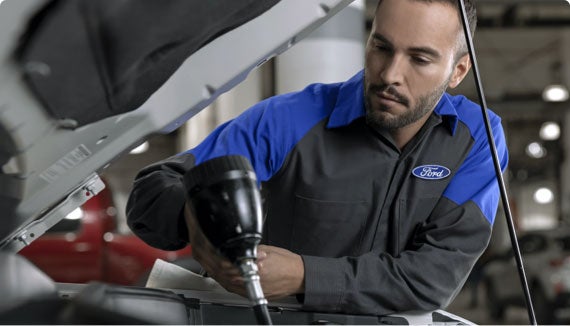
Overheating is a danger for your engine, as an excessively high temperature can damage vulnerable engine components. Your Ford has an efficient cooling system centered on the radiator that works to control the temperature. The radiator operates under high pressure, and this can eventually lead to damage. As your Ford dealer, we’d like you to know some signs you need to visit us for a radiator repair.
Signs You Need a Radiator Repair at Your Ford Dealer
Your Coolant Is Old
Coolant is an essential part of your cooling system, as it absorbs engine heat and transports it to the radiator where it’s removed by heat exchange. It’s released when your engine reaches a temperature between 195 F and 220 F and continues to circulate until the temperature falls below this level. Like the other fluids in your car, the coolant must be changed according to a set schedule.
After 30,000 miles, your coolant usually needs replacement. The exact time for replacement for your Ford model will be listed in your car’s manual. Older coolant becomes acidic, and this can cause corrosion in the cooling system. It also becomes less effective at absorbing heat, and this will cause your engine temperature to rise. We’ll fix this problem by drawing your coolant, flushing the cooling system, and refilling it with fresh coolant.
Rising Engine Temperature
The cooling system works to maintain a healthy engine operating temperature. If the temperature rises too high, the coolant movement will speed up in response. If your cooling system is working as it’s designed to, your engine temperature will hover around the middle of the temperature gauge. A sudden temperature rise, for example, when you accelerate, will quickly drop down again as the cooling system speeds up.
If your engine temperature rises for no apparent reason, there’s a problem with your cooling system. We advise that you pull over ASAP and allow your engine to cool. If the temperature continues to climb, we’ll need to examine your engine to find and fix the problem.
Loose Radiator Hoses
The radiator is connected to the cooling system by two rubber hoses. These hoses are securely attached to the radiator by strong metal clamps. The clamps ensure an airtight connection to prevent coolant from spilling out and to stop air from entering the cooling system.
The hoses move as the coolant passes through them, and they move slightly as you’re driving. Over time, these movements can loosen one or both of the clamps. This can lead to coolant leaks, and your engine temperature will rise. We’ll check your clamps and tighten or replace them.
If you suspect you have a problem with your radiator, call us ASAP at Kory Hooks Ford.



